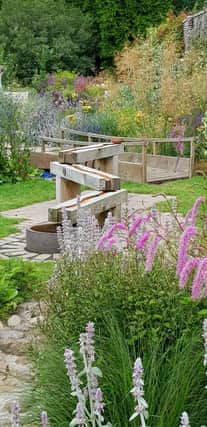GARDENING:


This is surely why we organise containers that overflow with bloom outside our homes, and feel the need to visit nearby floral attractions, something we`ve been deprived of for several months. Now we`re being encouraged to cautiously emerge from our homes, I`m making up for lost time, seizing the moment before summer slips from our grasp.
I recently reported on visiting a group of Craster village gardens and how it whetted the appetite for more. This encouraged us to return as volunteers to The Alnwick Garden, and visit Howick Hall last week. In each case entry was controlled, social distancing measures in place, and plenty of space for all.
Advertisement
Hide AdAdvertisement
Hide AdOutstanding floral displays were identified at each of the gardens visited which is quite exceptional given the furloughing of staff that both had experienced throughout lockdown.
At Alnwick it is the fragrance and variation of thousands of roses that leads the way, and it's such a pleasure to be working amongst them again, deadheading to encourage continuity of bloom. This attraction is ably supported by the Ornamental Garden, mature in structure and hosting a diversity of summer flowering plants. The typical summer scene becomes complete with visitors enjoying picnics on the lawn and gazing toward the Grand Cascade.
Under normal circumstances my voluntary involvement includes taking group tours around the Poison Garden, but that is currently not possible.
However, a modified, controlled system is in place, ensuring this important educational facility remains open. Two experienced staff ensure a limited number of entrants follow the one-way route whilst remaining socially distanced. QR boards are placed next to key poisonous plants, allowing those with QR readers on their mobiles to glean information.
Advertisement
Hide AdAdvertisement
Hide AdOur Howick Hall visit was real tonic, walking the grounds with colourful perennials, hosts of agapanthus and penstemon outstanding in the borders, astilbe and tall candelabra primulas in the bog garden, and luckily, Lady Howick`s private garden was open for a local charitable cause that morning. Then the outstanding Sensory Garden set up by North Northumberland Branch of the National Autistic Society, with funding help from National Gardening Scheme. It was designed by Natasha McEwen to provide a safe and stimulating environment where adults and children with autism can explore with their senses. Ornamental grasses, achillea and sanguisorba were the stars, and I noted a group of monarda a.k.a. bergamot, a reminder for this visitor that the Earl Grey Tea House was open and just a short walk away.
While we`re still taking our first cautious steps beyond the garden gate in pursuit of visits, the home plot is still capable of entertaining. Lucky you if there's daily access to containers, beds and borders filled with a variety of blooms. They are demanding of time but equally rewarding.
Early summer perennials have faded and are pruned to ground level in hope of secondary growth and a repeat performance. This serves to highlight those plants with staying power that prolong displays. In this respect, ours are a mixture of shrubs, sub-shrubs, herbaceous perennials, and annuals. My single shrub choice would be Lavatera ‘Baby Barnsley.’ It’s an improvement on the original `Barnsley` which grew way above our heads, required drastic pruning each year and aged rapidly. This slower-growing specimen was introduced for container cultivation but when planted in a border it levels out at around one metre high with a mixture of pink and white blooms throughout summer.
And although we have a mixture of rose types in the garden, hybrid tea, shrub, climbing, David Austin, some of which are highly fragrant, it's the tiny sweetheart that pleases most. `’Cecile Brunner’ has beautiful miniature form and is in constant bloom until the first hard frost. Several groups of lavender reflect our appreciation of their continuous flowering, ability to attract bees, colour, and fragrance. They`re pruned in autumn when blooms have faded by removing spent flowering stems and a small amount of summer growth. But be wary, if the pruning is too severe and into old wood, they can struggle to survive. Herbaceous perennials, nepeta, geranium, penstemon, and garden pinks, offer constant colour, while annual cosmos and rudbeckia have several cultivars that perform from June until deepest autumn.